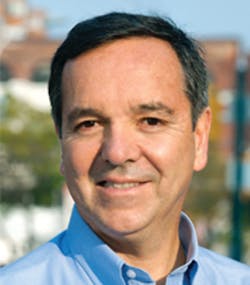With the global population ready to explode and young people opting to use transit instead of purchasing cars, planners are being urged to think more about integration of transit modes.
Gil Penalosa, executive director of 8-80 Cities told attendees of the APTA Annual Meeting in Chicago it’s time for cities to prepare for major changes in the population and to find ways to better accommodate residents in order to keep them happier and healthier for years to come.
“One of the key messages that I want to say today is walking, cycling and public transit got to be best friends,” he said. “They’re in the same boat.”
Penalosa spoke to APTA attendees Oct. 1, to highlight the lack of accommodations most cities across the world have taken to cater to pedestrians, bicyclists and those who use transit. The lack of planning is causing unsafe commuting environments for those not in a car and making it less appealing for many to switch to walking and transit.
One example is how bicycle lanes are set to the left of parked cars, exposing them to vehicle traffic. Penalosa said the bicyclists are protecting parked cars instead of parked cars protecting bicyclists.
When planning for pedestrians, Penalosa said it’s also important to make sure areas are safe for children and the elderly as they’re the most vulnerable. Often times planners will make pedestrian areas in front of schools safer than other areas, but Penalosa stressed it’s time to think about making the rest of the areas just as safe and for planners to think if they would be comfortable with their child walking there.
“Every trip begins with walking,” he said. “When we take transit, every transit trip begins by walking. Everyone.”
Although young adults are opting to not drive or buy cars, Penalosa said there still needs to be more efforts to make it more accommodating to people to use transit and to walk or bike. Some bus stops don’t protect riders from the elements and unsafe roads make it less appealing.
Planners and politicians continue to advocate about the needs of the future, but Penalosa said it’s time for people to start focusing on today.
“[In the U.S.] 90,000 people are hit by cars. Every year,” he said. “Over 5,000 of them die. It doesn’t make sense.”
Current issues will be further compounded by the explosion in population set to take place the next 50 years, with 2.5 billion more people expected to be in the world, along with a massive increase in the elderly population.
In the U.S. the population will increase by one-third, which Penalosa said means there needs to be an emphasis on improving cities while accommodating more residents. Planners and transportation officials needs to determine how people want to live for hundreds of years.
However, Penalosa said sometimes doing good isn’t always doing a good thing and to make a major impact can be a difficult venture.
“I’m not saying that this is the end of the car industry,” Penalosa said. “But one thing that is very, very clear is that the role of the car is changing. Very, very fast.”
About the Author
Joe Petrie
Associate Editor
I came to Mass Transit in 2013 after spending seven years on the daily newsbeat in southeastern Wisconsin.
Based in Milwaukee, I worked as a daily newspaper reporter with the Waukesha Freeman from 2006-2011, where I covered education, county and state government. I went on to cover courts for Patch.com, where I was the main courts reporter in the Metro Milwaukee cluster of websites.
I’ve won multiple awards during the course of my career and have covered some of the biggest political events in the past decade and have appeared on national programs.
Having covered local government and social issues, I discovered the importance of transit and the impact it can have on communities when implemented, supported and funded.

